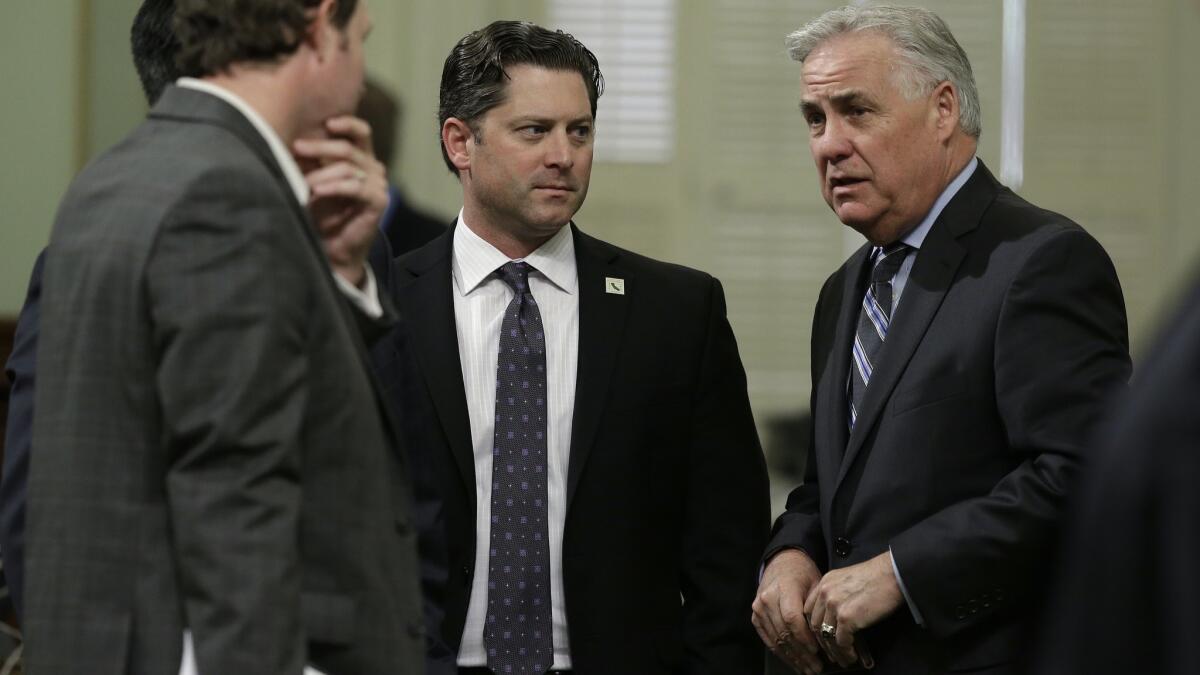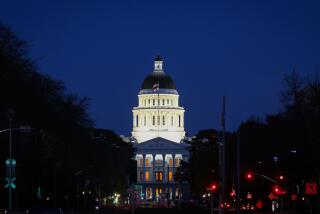California lawmakers meet deadline, sending nearly $200-billion state budget blueprint to Gov. Jerry Brown

Reporting from Sacramento — Both houses of the California Legislature took final action Thursday on an overarching framework and a few key details of a new state budget, sending the package to Gov. Jerry Brown one day before their legal deadline to take action.
Twenty-five separate pieces of legislation comprise the budget for the state government’s fiscal year that begins next month. Fourteen of the bills were sent to Brown on Thursday, while action is expected early next week on the remaining details.
Homeless spending gets a big boost in California budget deal between Brown and Democrats »
The $199.6-billion spending plan hews to Brown’s suggestion that a sizable portion of the state’s massive tax windfall be funneled into cash reserves as similar funds were last year, while increasing spending on K-12 education, healthcare and social services. It also provides more than $600 million for new efforts to help California’s homeless, a key component to the deal struck last week by the governor and Democratic legislative leaders.
“This is a solid budget,” Senate President Pro Tem Toni Atkins (D-San Diego) said. “And it builds upon what we’ve already done.”
Republicans provided only a few votes for the overall budget framework in the Assembly and Senate. Other GOP members insisted that the state continues to ignore long-term problems, including looming debt in the years to come.
“We’ve got to get ahead of this mess,” Sen. John Moorlach (R-Costa Mesa) said.
Democrats, however, insisted that the budget offers a reasonable approach to addressing the state’s needs. As is the case in most years, the lion’s share of spending is contained in three categories: education, health and human services, and corrections and rehabilitation.
“We continue our efforts to strengthen the state’s commitment to a human infrastructure,” said Sen. Holly Mitchell (D-Los Angeles), chairwoman of the Senate’s budget committee.
Under state constitutional mandates, K-12 schools and community colleges receive the single largest portion of general fund tax dollars. The new budget puts K-12 funding at $11,639 per student, up slightly from the current year. It includes a phase-in of an effort promoted by Brown to divvy up community college dollars with a new emphasis on student performance outcomes. It also provides $100 million in start-up funds for online community college courses and instruction.
Both the University of California and California State University systems receive funding increases under the budget agreement, though most of the education bills won’t be voted on until next week. The plan offers a combined $344-million one-time boost to the school systems, as well as new ongoing funding that’s expected to expand enrollment on UC and Cal State campuses while allowing university leaders to keep tuition at current levels.
Significant dollars will be spent, too, on health and human services. According to figures provided by the Assembly, almost 1 in 3 state dollars spent under the new budget will go to these programs. Much of it is earmarked for services provided by Medi-Cal, California’s version of Medicaid providing healthcare for its poorest citizens. Some care — including access to physicians, hospitals and child-screening services — is mandated by the federal government, while California adds additional benefits. The governor’s revised budget last month pegged Medi-Cal spending at about $35 billion in the coming fiscal year.
Democratic lawmakers pushed for more spending in one key social services program, persuading Brown to accept a small boost in monthly cash grants to the working poor enrolled in CalWORKS, the state’s welfare assistance program. Those monthly grants have remained unchanged for years, even as inflation pressures have reduced the purchasing power for low-income families. The budget adds $90 million to the grants beginning next spring, as well as a method to more fully fund annual cost-of-living increases in the future.
Subsidies for child care based on income and additional slots in preschool programs are also included in the budget framework. And both Brown and legislative leaders advocated for expanding access to California’s earned income tax credit to an additional 700,000 households. The tax credit, which provides cash to those with very low incomes, will be modified to account for increases in the state’s minimum wage, and it will be made available to workers between the ages of 18 and 24, and those over 65.
While spending increases under the plan, the budget reflects the continued insistence by Brown and lawmakers to stash funds for future economic downturns. Legislative staffers project that the budget passed Thursday will lead to a $15.9-billion cash reserve by next summer, larger than the general fund of 33 U.S. states.
The bulk of that money — $13.8 billion — will be in the “rainy-day fund” established by voters in 2014. Much of what’s left will be in the state’s regular cash reserves, while $200 million is being set aside in the event future budget deficits trigger cuts to CalWORKS.
Those dollars are the result of multibillion-dollar tax revenue windfalls, which have become surprisingly common in recent years. Lawmakers are taking steps in the new budget to change the process of how those dollars are set aside for future needs.
Stashing cash for a rainy day isn’t as easy as it sounds for California government »
But the mechanics are complicated. The plan to be signed into law by Brown includes a new and unusual “budget deficit savings account,” which will serve as an initial way station for surplus cash. Most of the money will ultimately be sent to the voter-approved reserve fund, but the accounting maneuver could offer new options for other excess dollars.
Some Republicans asked whether the proposal is a move to avoid triggering a 1979 state spending limit — one rarely breached since its inception and the focus of months of debate about how to properly calculate that limit. The provisions of that constitutional limit could require tax refunds.
“It’s been rigged so that no refund can ever be given to the taxpayers,” Assemblywoman Melissa Melendez (R-Lake Elsinore) said. “And that’s disgraceful.”
Others wondered whether a different plan involving tax windfalls — injected late into budget talks by Brown — would actually subsidize the state’s beleaguered high-speed rail project.
“We’ve set in motion a chain of events that this bill compounds,” Sen. Steve Glazer (D-Orinda) said.
Lawmakers were under the gun to pass key portions of the state budget by Friday or lose a portion of their salary under a 2010 law enacted by voters. That law also lowered the threshold for legislative passage to a simple majority in each house. Those two changes have helped create on-time California budgets for six straight years.
Follow @johnmyers on Twitter, sign up for our daily Essential Politics newsletter and listen to the weekly California Politics Podcast
More to Read
Get the L.A. Times Politics newsletter
Deeply reported insights into legislation, politics and policy from Sacramento, Washington and beyond. In your inbox three times per week.
You may occasionally receive promotional content from the Los Angeles Times.











